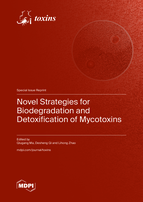Novel Strategies for Biodegradation and Detoxification of Mycotoxins
A special issue of Toxins (ISSN 2072-6651). This special issue belongs to the section "Mycotoxins".
Deadline for manuscript submissions: closed (31 March 2023) | Viewed by 39274
Special Issue Editors
Interests: mycotoxin bio-degradation; mycotoxin detoxification; feed-food safety; molecular toxicology of dietary mycotoxins
Special Issues, Collections and Topics in MDPI journals
Interests: feed safety; mycotoxin toxicology; fungistasis
Interests: mycotoxin; biodegradation of mycotoxin; molecular toxicity of foodstuff contaminants; nutritional, physical, chemical and biological mitigation strategies
Special Issues, Collections and Topics in MDPI journals
Special Issue Information
Dear Colleagues,
Mycotoxins contamination is a continuing global problem that severely affects animal health and performance, posing great food safety hazards. Eliminating feed mycotoxin contamination and hazards is the industry’s common aspiration.
In recent years, animal mycotoxin poisonings occurrs frequently all over the world. This has brought huge economic losses to the agriculture industry. The potential damage caused by mycotoxin-induced decreased disease resistance in animals and food safety problems is incalculable. There is a long way to go to prevent mycotoxin hazards.
Animals themselves have a certain ability to detoxify mycotoxins, and some bioactive substances like lipoic acid, sporoderm-broken spores of Ganderma lucidum, and quercetin can improve the detoxification ability of animals, so as to reduce the toxic effects of mycotoxins. On the other hand, biodegradation is a promising strategy to eliminate mycotoxins as it provides a possible means of transforming mycotoxins into nontoxic or less toxic metabolites under mild conditions, retaining the sensory quality and nutritional value of agricultural commodities.
This Special Issue of Toxins aims to gather contributions of original research or reviews related to novel strategies for biodegradation and detoxification of mycotoxins. Topics of interest will especially include novel mycotoxin-degrading microorganisms and enzymes, fermentation technology to reduce the mycotoxin content in cereal products, and studies on alleviating the mycotoxicosis of livestocks by the addition of bioactive substances or mycotoxin biodegradation agents.
Prof. Dr. Qiugang Ma
Prof. Dr. Desheng Qi
Dr. Lihong Zhao
Guest Editors
Manuscript Submission Information
Manuscripts should be submitted online at www.mdpi.com by registering and logging in to this website. Once you are registered, click here to go to the submission form. Manuscripts can be submitted until the deadline. All submissions that pass pre-check are peer-reviewed. Accepted papers will be published continuously in the journal (as soon as accepted) and will be listed together on the special issue website. Research articles, review articles as well as short communications are invited. For planned papers, a title and short abstract (about 100 words) can be sent to the Editorial Office for announcement on this website.
Submitted manuscripts should not have been published previously, nor be under consideration for publication elsewhere (except conference proceedings papers). All manuscripts are thoroughly refereed through a double-blind peer-review process. A guide for authors and other relevant information for submission of manuscripts is available on the Instructions for Authors page. Toxins is an international peer-reviewed open access monthly journal published by MDPI.
Please visit the Instructions for Authors page before submitting a manuscript. The Article Processing Charge (APC) for publication in this open access journal is 2700 CHF (Swiss Francs). Submitted papers should be well formatted and use good English. Authors may use MDPI's English editing service prior to publication or during author revisions.
Keywords
- Mycotoxins
- Biodegradation
- Detoxification
- Enzymes
- Microorganisms
- Bioactive substances









